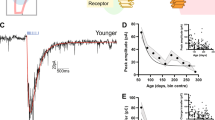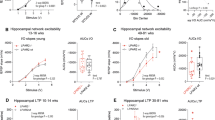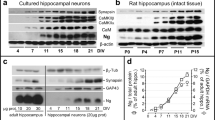Abstract
Nicotinic acetylcholine receptors have been shown to participate in neuroprotection in the aging brain. Lynx protein modulators dampen the activity of the cholinergic system through direct interaction with nicotinic receptors. Although lynx1 null mutant mice exhibit augmented learning and plasticity, they also exhibit macroscopic vacuolation in the dorsal striatum as they age, detectable at the optical microscope level. Despite the relevance of the lynx1 gene to brain function, little is known about the cellular ultrastructure of these age-related changes. In this study, we assessed degeneration in the dorsal striatum in 1-, 3-, 7-, and 13-month-old mice, using optical and transmission electron microscopy. We observed a loss of nerve fibers, a breakdown in nerve fiber bundles, and a loss of neuronal nuclei in the 13-month-old lynx1 null striatum. At higher magnification, these nerve fibers displayed intracellular vacuoles and disordered myelin sheaths. Few or none of these morphological alterations were present in younger lynx1 null mutant mice or in heterozygous lynx1 null mutant mice at any age. These data indicate that neuronal health can be maintained by titrating lynx1 dosage and that the lynx1 gene may participate in a trade-off between neuroprotection and augmented learning.









Similar content being viewed by others

References
Albuquerque EX, Pereira EF, Alkondon M, Rogers SW (2009) Mammalian nicotinic acetylcholine receptors: from structure to function. Physiol Rev 89:73–120
Berger F, Gage FH, Vijayaraghavan S (1998) Nicotinic receptor-induced apoptotic cell death of hippocampal progenitor cells. J Neurosci 18:6871–6881
Bordia T, Campos C, Huang L, Quik M (2008) Continuous and intermittent nicotine treatment reduces L-3,4-dihydroxyphenylalanine (L-DOPA)-induced dyskinesias in a rat model of Parkinson’s disease. J Pharmacol Exp Ther 327:239–247
Colquhoun LM, Patrick JW (1997) Pharmacology of neuronal nicotinic acetylcholine receptor subtypes. Adv Pharmacol 39:191–220
Costa G, Abin-Carriquiry JA, Dajas F (2001) Nicotine prevents striatal dopamine loss produced by 6-hydroxydopamine lesion in the substantia nigra. Brain Res 888:336–342
Court J, Clementi F (1995) Distribution of nicotinic subtypes in human brain. Alzheimer Dis Assoc Disord 9(Suppl 2):6–14
Cragg B (1980) Preservation of extracellular space during fixation of the brain for electron microscopy. Tissue Cell 12:63–72
Dajas F, Costa G, Abin-Carriquiry JA, McGregor R, Urbanavicius J (2001) Involvement of nicotinic acetylcholine receptors in the protection of dopamine terminals in experimental parkinsonism. Funct Neurol 16:113–123
Dajas-Bailador FA, Lima PA, Wonnacott S (2000) The alpha7 nicotinic acetylcholine receptor subtype mediates nicotine protection against NMDA excitotoxicity in primary hippocampal cultures through a Ca(2+) dependent mechanism. Neuropharmacology 39:2799–2807
Decker MW, McGaugh JL (1991) The role of interactions between the cholinergic system and other neuromodulatory systems in learning and memory. Synapse 7:151–168
Geula C, Nagykery N, Nicholas A, Wu CK (2008) Cholinergic neuronal and axonal abnormalities are present early in aging and in Alzheimer disease. J Neuropathol Exp Neurol 67:309–318
Hill JA Jr, Zoli M, Bourgeois J-P, Changeux J-P (1993) Immunocytochemical localization of a neuronal nicotinic receptor: The β2 subunit. J Neurosci 13:1551–1568
Huang LZ, Abbott LC, Winzer-Serhan UH (2007) Effects of chronic neonatal nicotine exposure on nicotinic acetylcholine receptor binding, cell death and morphology in hippocampus and cerebellum. Neuroscience 146:1854–1868
Ibanez-Tallon I, Miwa JM, Wang HL, Adams NC, Crabtree GW, Sine SM, Heintz N (2002) Novel modulation of neuronal nicotinic acetylcholine receptors by association with the endogenous prototoxin lynx1. Neuron 33:893–903
Kaneko S, Maeda T, Kume T, Kochiyama H, Akaike A, Shimohama S, Kimura J (1997) Nicotine protects cultured cortical neurons against glutamate-induced cytotoxicity via alpha7-neuronal receptors and neuronal CNS receptors. Brain Res 765:135–140
Khwaja M, McCormack A, McIntosh JM, Di Monte DA, Quik M (2007) Nicotine partially protects against paraquat-induced nigrostriatal damage in mice; link to α6β2* nAChRs. J Neurochem 100:180–190
Levin ED, McClernon FJ, Rezvani AH (2005) Nicotinic effects on cognitive function: behavioral characterization, pharmacological specification, and anatomic localization. Psychopharmacology (Berl) 1–17
McCallum SE, Parameswaran N, Bordia T, Fan H, Tyndale RF, Langston JW, McIntosh JM, Quik M (2006) Increases in α4* but not α3*/α6* nicotinic receptor sites and function in the primate striatum following chronic oral nicotine treatment. J Neurochem 96:1028–1041
Miwa JM, Ibanez-Tallon I, Crabtree GW, Sanchez R, Sali A, Role LW, Heintz N (1999) lynx1, an endogenous toxin-like modulator of nicotinic acetylcholine receptors in the mammalian CNS. Neuron 23:105–114
Miwa JM, Stevens TR, King SL, Caldarone BJ, Ibanez-Tallon I, Xiao C, Fitzsimonds RM, Pavlides C, Lester HA, Picciotto MR et al (2006) The prototoxin lynx1 acts on nicotinic acetylcholine receptors to balance neuronal activity and survival in vivo. Neuron 51:587–600
Miwa JM, Freedman R, Lester HA (2011) Neural systems governed by nicotinic acetylcholine receptors: emerging hypotheses. Neuron 70:20–33
Miwa JM, Lester HA, Walz A (2012) Optimizing cholinergic tone through lynx modulators of nicotinic receptors: implications for plasticity and nicotine addiction. Physiology (Bethesda) 4:187–199
Morishita H, Miwa JM, Heintz N, Hensch TK (2010) Lynx1, a cholinergic brake, limits plasticity in adult visual cortex. Science 330:1238–1240
O'Neill MJ, Murray TK, Lakics V, Visanji NP, Duty S (2002) The role of neuronal nicotinic acetylcholine receptors in acute and chronic neurodegeneration. Curr Drug Targets CNS Neurol Disord 1:399–411
Orb S, Wieacker J, Labarca C, Fonck C, Lester HA, Schwarz J (2004) Knockin mice with Leu9’Ser α4 nicotinic receptors: substantia nigra dopaminergic neurons are hypersensitive to agonist and lost postnatally. Physiol Genomics 18:299–307
Orr-Urtreger A, Broide RS, Kasten MR, Dang H, Dani JA, Beaudet AL, Patrick JW (2000) Mice homozygous for the L250T mutation in the α7 nicotinic acetylcholine receptor show increased neuronal apoptosis and die within 1 day of birth. J Neurochem 74:2154–2166
Perez XA, Bordia T, McItosh JM, Grady SR, Quik, M (2008) Long-term nicotine treatment differentially regulates striatal α6α4β2* and α6 (non-α4) β2* nAChR expression and function. Mol Pharmacol 74:844–853
Pfeffer CK, Stein V, Keating DJ, Maier H, Rinke I, Rudhard Y, Hentschke M, Rune GM, Jentsch TJ, Huebner CA (2009) NKCC1- dependent GABAergic excitation drives synaptic network maturation during early hippocampal development. J Neurosci 29: 3419–3430
Picciotto MR (2003) Nicotine as a modulator of behavior: beyond the inverted U. Trends Pharmacol Sci 24:493–499
Picciotto MR, Zoli M (2008) Neuroprotection via nAChRs: the role of nAChRs in neurodegenerative disorders such as Alzheimer’s and Parkinson’s disease. Front Biosci 13:492–504
Picciotto MR, Zoli M, Lena C, Bessis A, Lallemand Y, LeNovere N, Vincent P, Pich EM, Brulet P, Changeux JP (1995) Abnormal avoidance learning in mice lacking functional high-affinity nicotine receptor in the brain. Nature 374:65–67
Quik M, Kulak JM (2002) Nicotine and nicotinic receptors; relevance to Parkinson’s disease. Neurotoxicology 23:581–594
Quik M, Cox H, Parameswaran N, O'Leary K, Langston JW, Di Monte D (2007) Nicotine reduces levodopa-induced dyskinesias in lesioned monkeys. Ann Neurol 62:588–596
Ryan RE, Ross SA, Drago J, Loiacono RE (2001) Dose-related neuroprotective effects of chronic nicotine in 6-hydroxydopamine treated rats, and loss of neuroprotection in α4 nicotinic receptor subunit knockout mice. Br J Pharmacol 132:1650–1656
Schliebs R, Arendt T (2011) The cholinergic system in aging and neuronal degeneration. Behav Brain Res 221:555–563
Sekhon HS, Song P, Jia Y, Lindstrom J, Spindel ER (2005) Expression of lynx1 in developing lung and its modulation by prenatal nicotine exposure. Cell Tissue Res 320: 287–297
Spencer-Segal JL, Waters EM, Bath KG, Chao MV, McEwen BS, Milner TA (2011) Distribution of phosphorylated TrkB receptor in the mouse hippocampa; formation depends on sex and estrous cycle stage. J Neurosci 31: 6780–6790
Stevens TR, Krueger SR, Fitzsimonds RM, Picciotto MR (2003) Neuroprotection by nicotine in mouse primary cortical cultures involves activation of calcineurin and L-type calcium channel inactivation. J Neurosci 23:10093–10099
Tekinay AB, Nong Y, Miwa JM, Lieberam I, Ibanez-Tallon I, Greengard P, Heintz N (2009) A role for LYNX2 in anxiety-related behavior. Proc Natl Acad Sci U S A 106:4477–4482
Terry AV Jr, Buccafusco JJ (2003) The cholinergic hypothesis of age and Alzheimer’s disease-related cognitive deficits: recent challenges and their implications for novel drug development. J Pharmacol Exp Ther 306:821–827
Toulorge D, Guerreiro S, Hild A, Maskos U, Hirsch EC, Michel PP (2011) Neuroprotection of midbrain dopamine neurons by nicotine is gated by cytoplasmic Ca2+. FASEB J 25:2563–2573
Vijayaraghavan S, Pugh PC, Zhang ZW, Rathouz MM, Berg DK (1992) Nicotinic receptors that bind α-bungarotoxin on neurons raise intracellular free Ca2+. Neuron 8:353–362
Yamauchi JG, Nemecz A, Nguyen QT, Muller A, Schroeder LF, Talley TT, Lindstrom J, Kleinfeld D, Taylor P (2011) Characterizing ligand-gated ion channel receptors with genetically encoded Ca2++ sensors. PLoS One 6:e16519
Zoli M, Picciotto MR, Ferrari R, Cocchi D, Changeux JP (1999) Increased neurodegeneration during ageing in mice lacking high-affinity nicotine receptors. Embo J 18:1235–1244
Support Acknowledgments
This work was supported by funds from Tobacco-Related Disease Research Program of the University of California, Grant number TRDRP19KT-0032 for JMM and RLP, TRDRP22DT-0008 and NIH/NRSA Institutional training grant 5T32 GM07616 for RLP, US–India BRCP Award—1R21DA033831 for JMM, R01AG-033954 for HAL and JMM; R41DA032464, and 1R43MH094004 for PK, HB, APW, and AW. Financial support for this project included funds for undergraduate research from the College of Arts & Sciences and the Department of Biological Sciences at Lehigh University for KMO. The Jensen electron microscopy facility is funded in part by the Gordon and Betty Moore Foundation, the Agouron Institute, and the Beckman Foundation. Special thanks to Dr. Amber Rice for helpful discussions and critical reading of the manuscript. In memory of Andreas Walz.
Author information
Authors and Affiliations
Corresponding author
Rights and permissions
About this article
Cite this article
Kobayashi, A., Parker, R.L., Wright, A.P. et al. lynx1 Supports Neuronal Health in the Mouse Dorsal Striatum During Aging: an Ultrastructural Investigation. J Mol Neurosci 53, 525–536 (2014). https://doi.org/10.1007/s12031-014-0352-1
Received:
Accepted:
Published:
Issue Date:
DOI: https://doi.org/10.1007/s12031-014-0352-1



